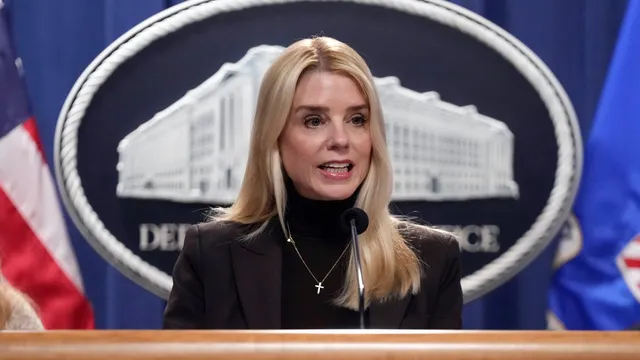
Pam Bondi orders inmate transfer for execution in Oklahoma
2025-02-15 12:52- Pam Bondi has ordered George John Hanson's transfer to Oklahoma for execution.
- Hanson was convicted and sentenced to death for kidnapping and killing Mary Bowles in Tulsa in 1999.
- The execution process is being prioritized to ensure justice for the victim's family and align with governmental policies on the death penalty.
Express your sentiment!
Insights
In a significant development concerning capital punishment in the United States, Pam Bondi, acting as the newly appointed Attorney General under President Donald Trump, has instructed the Federal Bureau of Prisons to transfer George John Hanson, a federal inmate, to Oklahoma for his execution. This order aligns with Trump's proactive stance on the death penalty, as outlined in a sweeping executive order that emphasizes support for the capital punishment system. Hanson's transfer is aimed at ensuring that the legal process surrounding his capital punishment sentence is activated as soon as possible. George John Hanson, currently 60 years old, was convicted in 2001 for the kidnapping and murder of 77-year-old Mary Bowles, which occurred in Tulsa, Oklahoma, in 1999. His heinous crime involved not only carjacking but also the brutal act of taking the life of an elderly woman who had been abducted from a shopping mall. After being sentenced to death in Oklahoma state court, he began serving a life sentence in federal prison in Louisiana due to previous federal convictions, including being identified as a career criminal. While in federal custody, his case did not proceed to execution until recent developments ignited renewed efforts to see his death sentence carried out. Oklahoma's legal system has experienced delays in executions amidst ongoing discussions and debates surrounding the death penalty in the state. Attorney General Gentner Drummond had previously requested the transfer of Hanson to ensure he would be eligible in time for the next scheduled execution, anticipated to occur in March. Bondi's memo explaining the decision emphasized the need for justice for Mary Bowles and her family, reinforcing the argument that the Department of Justice has an obligation to uphold this sentence as a reflection of societal values towards justice and punishment. With the involvement of federal authorities and the Oklahoma government now aligned, it brings to light a renewed effort to support the death penalty consistent with the Trump administration's focus on the issue. This case, in particular, demonstrates a concerted effort to navigate the complexities involved in transferring inmates facing execution, bridging the gaps between federal and state jurisdictions. Hence, while Hanson's legal team has yet to provide any commentary, the state's swift recognition of the order points toward a future execution that may serve to reignite the conversation about capital punishment in the United States more broadly.
Contexts
The practice of executions in the United States has a deep historical and sociopolitical context, evolving over the centuries from colonial times to the present day. Initially, capital punishment was seen as a necessary tool for deterrence and retribution, applied to various crimes ranging from murder to theft, reflecting the moral and legal sentiments of the time. Over the years, public opinion on the death penalty has fluctuated, influenced by media, notable cases, and changing societal norms regarding justice and human rights. This ebb and flow in public support has ultimately led to a patchwork of laws across different states, with some abolishing the death penalty entirely while others actively conduct executions, often sparking heated debates about its moral and ethical implications. The methods of execution have also evolved significantly, with lethal injection becoming the predominant technique in recent decades. This shift was ostensibly aimed at reducing the suffering associated with previous methods such as electrocution, gas chambers, and firing squads. However, issues relating to the effectiveness and humanity of lethal injection procedures have surfaced, particularly when executions have not proceeded as planned. High-profile botched executions have triggered protests and legal challenges, drawing attention to potential flaws in the implementation of capital punishment and raising questions about the transparency of the drugs used, as many pharmaceutical companies have distanced themselves from their use in executions. States that continue to impose the death penalty often cite reasons of deterrence and justice for victims and their families. Nevertheless, numerous studies have indicated that capital punishment does not effectively deter crime more than life imprisonment without parole. Additionally, concerns over wrongful convictions, racial bias, and the socioeconomic status of defendants have fueled arguments against the death penalty. There are powerful narratives from exonerated individuals who spent years on death row, sparking discussions about the fallibility of the judicial system and the irrevocable nature of the punishment. As of early 2025, the future of executions in the United States remains uncertain, with ongoing legislative reviews and court challenges. Some states have put moratoriums in place or have moved towards abolishing the death penalty altogether, while others continue to uphold it as a pillar of their criminal justice system. The national discourse surrounding executions continues to evolve, reflecting broader societal shifts in the perception of justice, punishment, and human rights, leaving a complex legacy that intertwines with the fabric of American history.